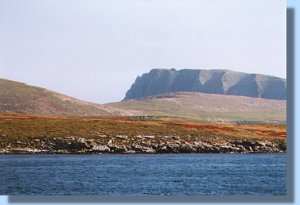 Today we'll have our first landing! Excitement fills the air and quite some
time before the first zodiac will leave the Polar Star, the first people gather
in the gangway waiting for their turn to enter one of the zodiacs.
Today we'll have our first landing! Excitement fills the air and quite some
time before the first zodiac will leave the Polar Star, the first people gather
in the gangway waiting for their turn to enter one of the zodiacs. We're anchored in Coffin's bay. Brown-green pastures interrupted by bright yellow and red patches of blooming flowers cover the island. In front of us we see the tiny settlement of New Island: half a dozen cottages and sheds. The weather looks promising. A bright sun is shining in a clear blue sky.
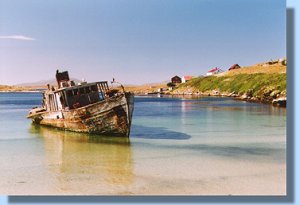
The sea is flat calm an a smooth ride brings us ashore where we are welcomed by Ian Strange, one of the few people living on this most westerly inhabited island of the Falklands. Ian is known for his efforts to protect the local widlife and he has put aside the southern half of the island as the New Island South Nature Reserve.
After changing our waterproof gear for something more comfortable, we start walking to the other side of the island, a 45 minute walk through gentle sloping fields.
When we get close to the other side, the sound of all kind of seabirds increases considerably. Albatrosses fly over in large quantities as well as cormorants, skuas and other birds. On the ground there's an abundance of rockhoppers. Frequently a penguin starts screaming because of another one coming to close or a skua flying over. Everywhere penguins are hopping up rocks to reach their nest sites.
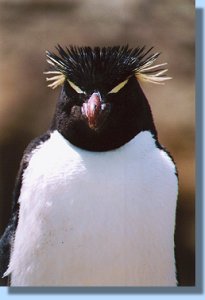
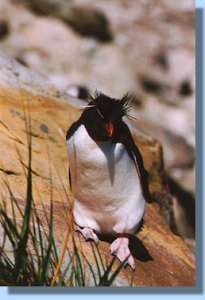
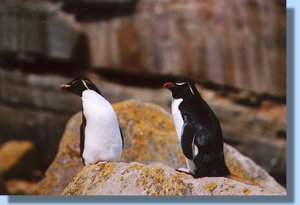 There are too much beautiful things to see (and photograph)
and film disappears in large quantities. The sun is high in the sky. Let's hope
the contrast isn't too high to produce nice images.
Slowly I walk around the colony. The sound remains deafening.
There are too much beautiful things to see (and photograph)
and film disappears in large quantities. The sun is high in the sky. Let's hope
the contrast isn't too high to produce nice images.
Slowly I walk around the colony. The sound remains deafening.
After a while I reach a different section of the colony. Instead of rockhoppers, the dominant species here is the black-browed albatross. Most of the albatrosses in the colony are breeding. A small bowl shaped platform made of mud forms the nest. Over the years these nests can reach a height of about 20-30 centimeters. Once every while an albatross stands up providing us with a good look inside its nest. The chicks are larger in size than I'd expected and because of this size already less vulnerable to predators like skuas and caracaras. Then the parent sits down again and the chick is again hidden underneath the body of its parent. It must be pretty warm down there.
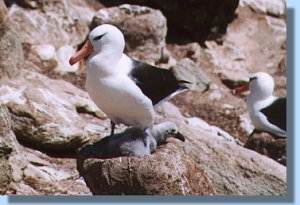
Slowly we walk back to the beginning of the colony. At this side a small path disappears between the tussock grass. We decide to follow it and disappear to our chest in the tussock grass. After a hundred meters we reach the edge of a cliff. Fortunately it's possible to climb down to the sea here but the tussock grass, the steep slope and the loose stones that cover the slopes make it a tricky walk. Carefully we walk down and finally after having climbed over some large boulders we reach the beach. Steep cliffs rise up around us and a pair of rockhoppers is watching us with curious eyes.
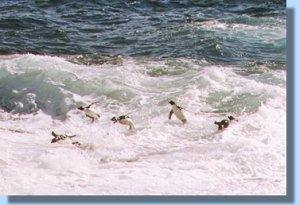
In front of us large waves break on the rocky shore. About 30-40 meters out in the sea a large amount of penguins is swimming around. Suddenly they all start swimming towards the shore. And just as sudden they all swim out again. The reason for this behavior is clear: a sea lion is patrolling around ready for a tasty rockhopper. Then they all make a second try porpoising through the waves. But this attempt to land is cancelled as well and they remain swimming in front of the beach for a while.
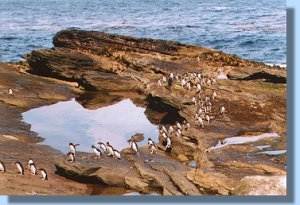 The third time they decide to continue the landing and amidst
the rolling waves a group of 20-30 penguins reach the shore. As quickly as they
can they leave the danger zone and in a long line they hop to the safety of
their colony several tens of meters away from the sea. Fifteen minutes later
a second large group reaches the safety of the colony. The rest of the afternoon
shows us several more landings of penguins.
The third time they decide to continue the landing and amidst
the rolling waves a group of 20-30 penguins reach the shore. As quickly as they
can they leave the danger zone and in a long line they hop to the safety of
their colony several tens of meters away from the sea. Fifteen minutes later
a second large group reaches the safety of the colony. The rest of the afternoon
shows us several more landings of penguins.
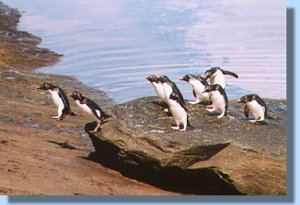
Not all penguins go to sea. Several can be seen swimming in tidepools. They seem to like it. For sure it's much safer and still offers the possibility to get rid of guano, but to catch fish in order to feed it won't do.
Here again many albatrosses in the sky, skuas that try to snatch a penguin chick, a couple of sheatbills and a pair of striated caracaras in courtship display. Much too soon it's time to climb up the cliff again.
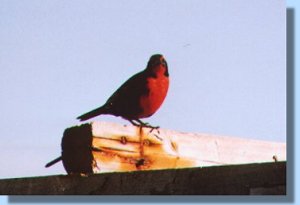 The climb up is easier than expected and soon we're back at the first colony.
The climb up is easier than expected and soon we're back at the first colony.
After a last look we're heading back for the zodiacs. A red meadowlark greets us when we leave the beach. Back on board the captain raises the anchor for a couple of hours to our next destination: West Point Island. During dinner we celebrate New Year and toast on a very good 2003 in general and a great trip in particular!